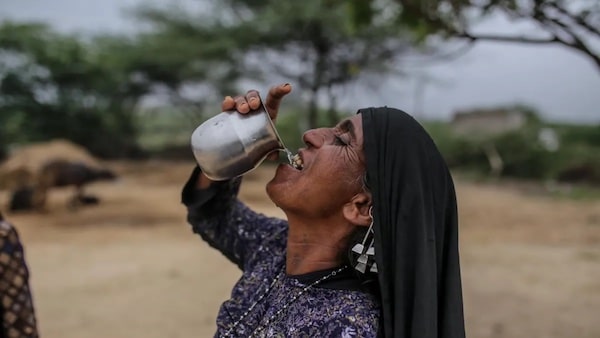Brutal, record-intensity heat wave that has engulfed much of India and Pakistan since March eased somewhat this week, but is poised to roar back in the coming week with inferno-like temperatures of up to 50 degrees Celsius (122°F). The heat, when combined with high levels of humidity – especially near the coast and along the Indus River Valley – will produce dangerously high levels of heat stress that will approach or exceed the limit of survivability for people outdoors for an extended period.
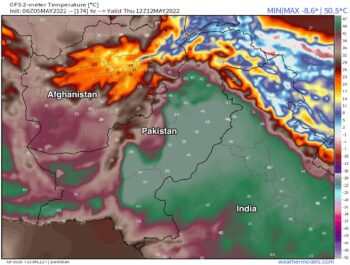
Figure 1. Predicted temperatures for Pakistan and northwestern India at 12Z Thursday, May 12, 2022, from the 6Z Thursday, May 5, run of the GFS model. The model predicted temperatures of 45-50 degrees Celsius (113-122°F) over a large region. (Photo: weathermodels.com)
The latest forecasts from the GFS and European models predict an unusually strong region of high pressure intensifying over southern Asia in the coming week, bringing increasing heat that will peak on May 11-12, with highs near 50 degrees Celsius (122°F) near the India/Pakistan border. May is typically the region’s hottest month, and significant relief from the heat wave may not occur until the cooling rains of the Southwest Monsoon arrive in June. But tropical cyclones are also common in May in the northern Indian Ocean, and a landfalling storm could potentially bring relief from the heat wave.
Hottest March in record in India
According to the World Meteorological Organization, India recorded its hottest March on record, with an average maximum temperature of 33.1 degrees Celsius, or 1.86 degrees above the long-term average. Pakistan recorded its warmest March for at least the past 60 years. April was record-hot over northwestern India, and was the fourth-hottest April for all of India. The heat peaked on May 1, when Nawabshah, Pakistan, hit 49.5 degrees Celsius (120.2°F) – the hottest temperature recorded on Earth so far in 2022.
According to an excellent analysis by James Peacock of metswift.com, the current La Niña event in the eastern Pacific contributed to the March and April heat, by reducing the pre-monsoonal rains that typically fall. These dry conditions have led to abnormally high heat and wildfire conditions. In addition, Earth’s warming climate has brought conditions more favorable for more intense and longer-lasting heat waves. In northwestern India, the number of days with temperatures reaching at least 40 degrees Celsius (104°F) increased from 25 per year in the 1970s to 45 per year in the 2010s; the duration of the worst heat waves has approximately doubled.
The extreme heat in April which impacted Pakistan & India was part of a huge region of anomalous warmth which reached from Equatorial Africa all the way to the Arctic. pic.twitter.com/JssILtjPGt
— Scott Duncan (@ScottDuncanWX) May 4, 2022
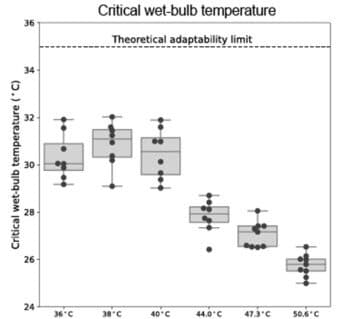
Figure 2. Critical wet-bulb temperature for young, healthy people in six different experimental scenarios. (Credit: Vecellio et al., 2022, Evaluating the 35°C wet-bulb temperature adaptability threshold for young, healthy subjects (PSU Heat Project), Journal of Applied Physiology, https://doi.org/10.1152/japplphysiol.00738.2021)
Because of the heat wave, India’s wheat crop is expected to be 4% lower than the 2021 harvest, breaking a string of five consecutive record harvests. Even with the heat wave, India’s wheat exports could beat last year’s shipments, helping replace the lack of wheat exports from Ukraine and Russia this year. However, some traders project that export restrictions may occur in India because of the heat wave.
‘Unsurvivable’ heat occurred during the heat wave
While the heat index – which measures heat stress due to high temperatures combined with high humidity – is often used to quantify dangerous heat, a more precise measure of heat stress is the wet-bulb temperature, which can be measured by putting a wet cloth around the bulb of a thermometer and then blowing air across the cloth. The wet-bulb temperature increases with increasing temperature and humidity and is a measure of “mugginess.”
Since human skin temperature averages close to 35 degrees Celsius (95°F), wet-bulb temperatures above that critical value prevent all people from dispelling internal heat, leading to fatal consequences within six hours, even for healthy people in well-ventilated conditions. The U.S. National Weather Service defines the “Danger” threshold for wet-bulb at 24.6 degrees Celsius (76.3°F), and “Extreme Danger” at 29.1 degrees Celsius (84.4°F), assuming a 45% relative humidity.
However, experiments show that a wet-bulb temperature considerably lower—near 31 degrees Celsius (88°F)—is likely fatal for young, healthy people. A 2022 study, Evaluating the 35°C wet-bulb temperature adaptability threshold for young, healthy subjects, had participants swallow a tiny radio telemetry device encased in a capsule that measured their core temperature while performing tasks mimicking basic activities of daily life, until they could no longer maintain their core temperature without overheating. The experiment found that young, healthy adults could not survive extended exposure to wet-bulb temperatures of 30-31 degrees Celsius (86-88°F) in humid environments, and 25-28 degrees Celsius (77-82°F) in hotter, dryer environments (see the paper’s press release, and Figure 2). For older people, and those with health conditions, the critical wet-bulb temperature is likely even lower.
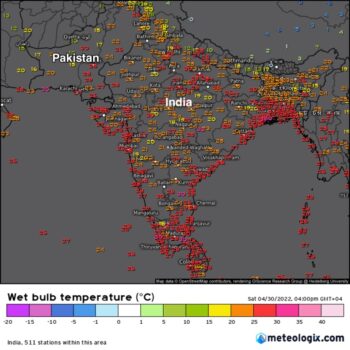
Figure 3. Wet-bulb temperatures at 12Z April 30, 2022, over much of India and Pakistan exceeded 28 degrees Celsius—a dangerously high level. (Photo: meteorologix.com)
During the hottest portions of the day at the peak of last week’s heat wave, April 29-30, wet-bulb temperatures in northwestern India and eastern Pakistan regularly exceeded the critical threshold for young, healthy adults identified in the study. For example, at 12Z April 30 (Figure 3), the ambient temperature at Nawabshah, Pakistan, was 46 Celsius, and peaked at 47.4 degrees Celsius. At that those temperatures, the critical wet-bulb temperature is 27-28 degrees Celsius; the observed wet-bulb temperature was two degrees higher: 29-30 degrees Celsius. Coastal regions of India near the megacities of Kolkata and Mumbai had wet-bulb temperatures in excess of 30 degrees Celsius on multiple days of the heat wave.
Death toll at 26 for India’s 2022 heat wave
So far, 25 deaths resulting from the heat wave have been reported since late March in India’s Maharashtra state, which includes Mumbai. An additional heat death was reported on April 25 in the eastern state of Odisha. However, heat deaths are prone to undercounting. The World Health Organization estimated that India undercounted its COVID-19 deaths by about a factor of eight, which brings into question the veracity of India’s heat wave mortality statistics. Fortunately, India has learned to adapt to the increasing extreme heat in recent years, with lower death tolls occurring during heat waves (see Tweet below). One worrying aspect of the current heat wave, though, is the large-scale power outages that have occurred. With air conditioning availability reduced from power shortages, India’s ability to adapt to the high heat is reduced. Approximately 12% of India’s 1.4 billion people have air conditioning; the situation is similar in Pakistan.
4/ As per IMD forecasts, severe heatwave is to continue for 1 May over Indo-Pak region to north- central India. It will gradually decrease to isolated pockets during 2-3 May. Temperatures over these regions will still be above 40C, but a short respite is expected during 4-7 May. pic.twitter.com/70hdBwh7AE
— Roxy Koll ⛈ (@rocksea) April 30, 2022
‘Unsurvivable’ heat increasing as result of climate change
A 2020 paper in the open-access journal Science Advances by Raymond et al., “Potentially Fatal Combinations of Humidity and Heat Are Emerging across the Globe,” identified 14 examples of 35 degrees Celsius wet-bulb readings that have already occurred since 1987 at five stations in Pakistan, Saudi Arabia, and the United Arab Emirates (UAE). These conditions generally lasted less than six hours (see Bob Henson’s May 2020 post for details).
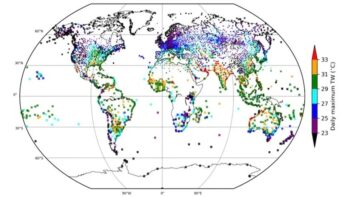
Figure 4. Maximum values of wet-bulb temperature, TW, (degrees Celsius) for the period 1979-2017 at weather stations that had at least 50% data availability. (Image credit: Raymond et al., 2020, “The emergence of heat and humidity too severe for human tolerance”, Sci. Adv. 6, eaaw1838 (2020) DOI: 10.1126/sciadv.aaw1838)
Those researchers found that the frequency of wet-bulb values reaching 27°C, 29°C, 31°C, and 33°C across the world all showed doubling trends between 1979 and 2017. They predicted that dangerous wet-bulb readings will continue to spread across vulnerable parts of the world, affecting millions more people, as human-caused climate change continues.
Higher wet-bulb temperatures will be particularly dangerous in the Indus River Valley along the India/Pakistan border, where thousands of laborers work outdoors in pre-monsoon heat that can reach dangerous levels during April through July. Jacobabad, Pakistan (population 191,000), has already recorded six days when the wet-bulb temperature exceeded the limit of human survivability: 35 degrees Celsius.
A 2015 heat wave killed 3,477 people in India/Pakistan, ranking as the fourth deadliest heat wave in world history, according to the international disaster database, EM-DAT. Four of the 11 heat waves with a death toll in excess of 1,000 in the EM-DAT database have affected India and/or Pakistan. Below are the heat waves with a death toll exceeding 1,000, as compiled by EM-DAT (which uses direct deaths for their statistics, and not excess mortality). Note that heat wave death statistics are highly uncertain, however:
The 11 Deadliest Heat Waves in World History:
1) Europe, 2003: 71,310
2) Russia, 2010: 55,736
3) France/Belgium, 2015: 3,685
4) India/Pakistan, 2015: 3,477
5) Europe, 2006: 3,418
6) India, 1998: 2,541
7) U.S. and Canada, 1936: 1,693
8) India/Pakistan/Bangladesh, 2003: 1,472
9) U.S., 1980: 1,260
10) U.S./Canada, 2021: 1037
11) India, 2002: 1,030
Bob Henson contributed to this post.
Jeff Masters, Ph.D., worked as a hurricane scientist with the NOAA Hurricane Hunters from 1986-1990. After a near-fatal flight into category 5 Hurricane Hugo, he left the Hurricane Hunters to pursue a safer passion – earning a 1997 Ph.D. in air pollution meteorology from the University of Michigan. In 1995, he co-founded the Weather Underground, and served as its chief meteorologist and on its Board of Directors until it was sold to the Weather Company in 2012. Between 2005-2019, his Category 6 blog was one of the Internet’s most popular and widely quoted sources of extreme weather and climate change information.

